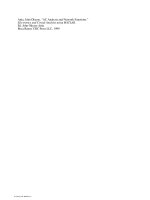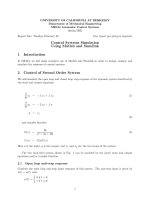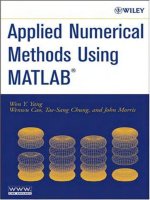Applied Econometrics Using Matlab
Bạn đang xem bản rút gọn của tài liệu. Xem và tải ngay bản đầy đủ của tài liệu tại đây (1.41 MB, 348 trang )
Applied Econometrics using MATLAB
James P. LeSage
Department of Economics
University of Toledo
October, 1999
Preface
This text describes a set of MATLAB functions that implement a host of
econometric estimation methods. Toolboxes are the name given by the
MathWorks to related sets of MATLAB functions aimed at solving a par-
ticular class of problems. Toolboxes of functions useful in signal processing,
optimization, statistics, finance and a host of other areas are available from
the MathWorks as add-ons to the standard MATLAB software distribution.
I use the term Econometrics Toolbox to refer to the collection of function
libraries described in this book.
The intended audience is faculty and students using statistical methods,
whether they are engaged in econometric analysis or more general regression
modeling. The MATLAB functions described in this book have been used
in my own research as well as teaching both undergraduate and graduate
econometrics courses. Researchers currently using Gauss, RATS, TSP, or
SAS/IML for econometric programming might find switching to MATLAB
advantageous. MATLAB software has always had excellent numerical algo-
rithms, and has recently been extended to include: sparse matrix algorithms,
very good graphical capabilities, and a complete set of object oriented and
graphical user-interface programming tools. MATLAB software is available
on a wide variety of computing platforms including mainframe, Intel, Apple,
and Linux or Unix workstations.
When contemplating a change in software, there is always the initial
investment in developing a set of basic routines and functions to support
econometric analysis. It is my hope that the routines in the Econometrics
Toolbox provide a relatively complete set of basic econometric analysis tools.
The toolbox also includes a number of functions to mimic those available
in Gauss, which should make converting existing Gauss functions and ap-
plications easier. For those involved in vector autoregressive modeling, a
complete set of estimation and forecasting routines is available that imple-
ment a wider variety of these estimation methods than RATS software. For
example, Bayesian Markov Chain Monte Carlo (MCMC) estimation of VAR
i
ii
models that robustify against outliers and accommodate heteroscedastic dis-
turbances have been implemented. In addition, the estimation functions for
error correction models (ECM) carry out Johansen’s tests to determine the
number of cointegrating relations, which are automatically incorporated in
the model. In the area of vector autoregressive forecasting, routines are
available for VAR and ECM methods that automatically handle data trans-
formations (e.g. differencing, seasonal differences, growth rates). This allows
users to work with variables in raw levels form. The forecasting functions
carry out needed transformations for estimation and return forecasted values
in level form. Comparison of forecast accuracy from a wide variety of vector
autoregressive, error correction and other methods is quite simple. Users
can avoid the difficult task of unraveling transformed forecasted values from
alternative estimation methods and proceed directly to forecast accuracy
comparisons.
The collection of around 300 functions and demonstration programs are
organized into libraries that are described in each chapter of the book. Many
faculty use MATLAB or Gauss software for research in econometric analysis,
but the functions written to support research are often suitable for only a
single problem. This is because time and energy (both of which are in short
supply) are involved in writing more generally applicable functions. The
functions described in this book are intended to be re-usable in any number
of applications. Some of the functions implement relatively new Markov
Chain Monte Carlo (MCMC) estimation methods, making these accessible
to undergraduate and graduate students with absolutely no programming
involved on the students part. Many of the automated features available in
the vector autoregressive, error correction, and forecasting functions arose
from my own experience in dealing with students using these functions. It
seemed a shame to waste valuable class time on implementation details when
these can be handled by well-written functions that take care of the details.
A consistent design was implemented that provides documentation, ex-
ample programs, and functions to produce printed as well as graphical pre-
sentation of estimation results for all of the econometric functions. This
was accomplished using the “structure variables” introduced in MATLAB
Version 5. Information from econometric estimation is encapsulated into a
single variable that contains “fields” for individual parameters and statistics
related to the econometric results. A thoughtful design by the MathWorks
allows these structure variables to contain scalar, vector, matrix, string,
and even multi-dimensional matrices as fields. This allows the econometric
functions to return a single structure that contains all estimation results.
These structures can be passed to other functions that can intelligently de-
iii
cipher the information and provide a printed or graphical presentation of
the results.
The Econometrics Toolbox should allow faculty to use MATLAB in un-
dergraduate and graduate level econometrics courses with absolutely no pro-
gramming on the part of students or faculty. An added benefit to using
MATLAB and the Econometrics Toolbox is that faculty have the option of
implementing methods that best reflect the material in their courses as well
as their own research interests. It should be easy to implement a host of ideas
and methods by: drawing on existing functions in the toolbox, extending
these functions, or operating on the results from these functions. As there is
an expectation that users are likely to extend the toolbox, examples of how
to accomplish this are provided at the outset in the first chapter. Another
way to extend the toolbox is to download MATLAB functions that are avail-
able on Internet sites. (In fact, some of the routines in the toolbox originally
came from the Internet.) I would urge you to re-write the documentation
for these functions in a format consistent with the other functions in the
toolbox and return the results from the function in a “structure variable”.
A detailed example of how to do this is provided in the first chapter.
In addition to providing a set of econometric estimation routines and doc-
umentation, the book has another goal. Programming approaches as well as
design decisions are discussed in the book. This discussion should make it
easier to use the toolbox functions intelligently, and facilitate creating new
functions that fit into the overall design, and work well with existing toolbox
routines. This text can be read as a manual for simply using the existing
functions in the toolbox, which is how students tend to approach the book.
It can also be seen as providing programming and design approaches that
will help implement extensions for research and teaching of econometrics.
This is how I would think faculty would approach the text. Some faculty
in Ph.D. programs expect their graduate students to engage in econometric
problem solving that requires programming, and certainly this text would
eliminate the burden of spending valuable course time on computer pro-
gramming and implementation details. Students in Ph.D. programs receive
the added benefit that functions implemented for dissertation work can be
easily transported to another institution, since MATLAB is available for
almost any conceivable hardware/operating system environment.
Finally, there are obviously omissions, bugs and perhaps programming
errors in the Econometrics Toolbox. This would likely be the case with any
such endeavor. I would be grateful if users would notify me when they en-
counter problems. It would also be helpful if users who produce generally
useful functions that extend the toolbox would submit them for inclusion.
iv
Much of the econometric code I encounter on the internet is simply too
specific to a single research problem to be generally useful in other appli-
cations. If econometric researchers are serious about their newly proposed
estimation methods, they should take the time to craft a generally useful
MATLAB function that others could use in applied research. Inclusion in
the Econometrics Toolbox would also have the benefit of introducing the
method to faculty teaching econometrics and their students.
The latest version of the Econometrics Toolbox functions can be found on
the Internet at: under the MATLAB gallery
icon. Instructions for installing these functions are in an Appendix to this
text along with a listing of the functions in the library and a brief description
of each.
Acknowledgements
First I would like to acknowledge my students who suffered through previous
buggy and error filled versions of the toolbox functions. I owe a great deal to
their patience and persistence in completing projects under such conditions.
I would like to thank Michael R. Dowd would was brave enough to use
early versions of the vector autoregressive library routines in his research.
In addition to providing feedback regarding the functions and reading early
drafts of the text, Mike also provided LaTeX assistance to produce this text.
David C. Black is another faculty colleague who tested many of the functions
and read early drafts of the text. Michael Magura who has always been a
great editor and helpful critic also read early drafts of the text.
Some of the functions in the Econometrics Toolbox represent algorithms
crafted by others who unselfishly placed them in the public domain on the
Internet. The authors names and affiliations have been preserved in these
functions. In all cases, the documentation was modified to match the format
of the Econometrics Toolbox and in many cases, the arguments returned
by the function were converted to MATLAB structure variables. In other
cases, functions written in other languages were converted to the MATLAB
language. I am indebted to those who implemented these routines as well.
The following persons have generously contributed their functions for
inclusion in the Econometrics Toolbox. C. F. Baum from Boston College,
Mike Cliff from UNC, Matt Hergott a Duke B-school graduate and Tony
E. Smith from University of Pennsylvania. Tony also spent a great deal of
time looking at the spatial econometrics functions and reporting problems
and bugs.
Many others have sent e-mail comments regarding errors and I am grate-
ful to all of you.
v
Contents
1 Introduction 1
2 Regression using MATLAB 5
2.1 Design of the regression library 6
2.2 The ols function 8
2.3 Selecting a least-squares algorithm 12
2.4 Using the results structure 17
2.5 Performance profiling the regression toolbox 28
2.6 Using the regression library 30
2.6.1 A Monte Carlo experiment 31
2.6.2 Dealing with serial correlation 32
2.6.3 Implementing statistical tests 38
2.7 Chapter summary 41
Chapter 2 Appendix 42
3 Utility Functions 45
3.1 Calendar function utilities 45
3.2 Printing and plotting matrices 49
3.3 Data transformation utilities 65
3.4 Gauss functions 69
3.5 Wrapper functions 73
3.6 Chapter summary 76
Chapter 3 Appendix 77
4 Regression Diagnostics 80
4.1 Collinearity diagnostics and procedures 80
4.2 Outlier diagnostics and procedures 94
4.3 Chapter summary 100
vi
CONTENTS vii
Chapter 4 Appendix 101
5 VAR and Error Correction Models 103
5.1 VAR models 103
5.2 Error correction models 113
5.3 Bayesian variants 125
5.3.1 Theil-Goldberger estimation of these models 138
5.4 Forecasting the models 139
5.5 Chapter summary 145
Chapter 5 Appendix 148
6 Markov Chain Monte Carlo Models 151
6.1 The Bayesian Regression Model 154
6.2 The Gibbs Sampler 156
6.2.1 Monitoring convergence of the sampler 159
6.2.2 Autocorrelation estimates 163
6.2.3 Raftery-Lewis diagnostics 163
6.2.4 Geweke diagnostics 165
6.3 A heteroscedastic linear model 169
6.4 Gibbs sampling functions 175
6.5 Metropolis sampling 184
6.6 Functions in the Gibbs sampling library 190
6.7 Chapter summary 197
Chapter 6 Appendix 199
7 Limited Dependent Variable Models 204
7.1 Logit and probit regressions 206
7.2 Gibbs sampling logit/probit models 211
7.2.1 The probit
g function 218
7.3 Tobit models 220
7.4 Gibbs sampling Tobit models 224
7.5 Chapter summary 227
Chapter 7 Appendix 228
8 Simultaneous Equation Models 230
8.1 Two-stage least-squares models 230
8.2 Three-stage least-squares models 235
8.3 Seemingly unrelated regression models 240
CONTENTS viii
8.4 Chapter summary 244
Chapter 8 Appendix 246
9 Distribution functions library 247
9.1 The pdf, cdf, inv and rnd functions 248
9.2 The specialized functions 249
9.3 Chapter summary 256
Chapter 9 Appendix 257
10 Optimization functions library 260
10.1 Simplex optimization 261
10.1.1 Univariate simplex optimization 261
10.1.2 Multivariate simplex optimization 268
10.2 EM algorithms for optimization 269
10.3 Multivariate gradient optimization 278
10.4 Chapter summary 287
Chapter 10 Appendix 288
11 Handling sparse matrices 289
11.1 Computational savings with sparse matrices 289
11.2 Estimation using sparse matrix algorithms 297
11.3 Gibbs sampling and sparse matrices 304
11.4 Chapter summary 309
Chapter 11 Appendix 310
References 313
Appendix: Toolbox functions 320
List of Examples
1.1 Demonstrate regression using the ols() function 8
2.2 Least-squares timing information 12
2.3 Profiling the ols() function 28
2.4 Using the ols() function for Monte Carlo 31
2.5 Generate a model with serial correlation 33
2.6 Cochrane-Orcutt iteration 34
2.7 Maximum likelihood estimation 37
2.8 Wald’s F-test 38
2.9 LM specification test 40
3.1 Using the cal() function 47
3.2 Using the tsdate() function 48
3.3 Using cal() and tsdates() functions 49
3.4 Reading and printing time-series 49
3.5 Using the lprint() function 51
3.6 Using the tsprint() function 56
3.7 Various tsprint() formats 58
3.8 Truncating time-series and the cal() function 60
3.9 Common errors using the cal() function 60
3.10 Using the tsplot() function 61
3.11 Finding time-series turning points with fturns() 64
3.12 Seasonal differencing with sdiff() function 67
3.13 Annual growth rates using growthr() function 68
3.14 Seasonal dummy variables using sdummy() function 68
3.15 Least-absolute deviations using lad() function 71
4.1 Collinearity experiment 82
4.2 Using the bkw() function 86
4.3 Using the ridge() function 88
4.4 Using the rtrace() function 90
4.5 Using the theil() function 92
4.6 Using the dfbeta() function 94
ix
LIST OF EXAMPLES x
4.7 Using the robust() function 97
4.8 Using the pairs() function 99
5.1 Using the var() function 105
5.2 Using the pgranger() function 107
5.3 VAR with deterministic variables 110
5.4 Using the lrratio() function 111
5.5 Impulse response functions 112
5.6 Using the adf() and cadf() functions 116
5.7 Using the johansen() function 119
5.8 Estimating error correction models 123
5.9 Estimating BVAR models 128
5.10 Using bvar() with general weights 130
5.11 Estimating RECM models 137
5.12 Forecasting VAR models 140
5.13 Forecasting multiple related models 141
5.14 A forecast accuracy experiment 143
6.1 A simple Gibbs sampler 157
6.2 Using the coda() function 160
6.3 Using the raftery() function 165
6.4 Geweke’s convergence diagnostics 166
6.5 Using the momentg() function 168
6.6 Heteroscedastic Gibbs sampler 173
6.7 Using the ar
g() function 182
6.8 Metropolis within Gibbs sampling 188
6.9 Bayesian model averaging with the bma
g() function 192
7.1 Logit and probit regression functions 206
7.2 Demonstrate Albert-Chib latent variable 212
7.3 Gibbs vs. maximum likelihood logit 214
7.4 Gibbs vs. maximum likelihood probit 215
7.5 Heteroscedastic probit model 217
7.6 Tobit regression function 222
7.7 Gibbs sampling tobit estimation 225
8.1 Two-stage least-squares 231
8.2 Monte Carlo study of ols() vs. tsls() 234
8.3 Three-stage least-squares 237
8.4 Using the sur() function 242
9.1 Beta distribution function example 248
9.2 Random Wishart draws 252
9.3 Left- and right-truncated normal draws 253
9.4 Rejection sampling of truncated normal draws 254
LIST OF EXAMPLES xi
10.1 Simplex maximum likelihood for Box-Cox model 265
10.2 EM estimation of switching regime model 275
10.3 Maximum likelihood estimation of the Tobit model 281
10.4 Using the optsolv() function 286
11.1 Using sparse matrix functions 291
11.2 Solving a sparse matrix system 292
11.3 Symmetric minimum degree ordering operations 295
11.4 Solving for rho using the far() function 303
11.5 Gibbs sampling with sparse matrices 307
List of Figures
2.1 Histogram of
ˆ
β outcomes 33
3.1 Output from tsplot() function 62
3.2 Graph of turning point events 66
4.1 Ridge trace plot 91
4.2 Dfbeta plots 95
4.3 Dffits plots 96
4.4 Pairwise scatter plots 99
5.1 Impulse response graphs 113
5.2 Prior means and precision for important variables 136
5.3 Prior means and precision for unimportant variables 137
6.1 Prior V
i
distributions for various values of r 171
6.2 Mean of V
i
draws 176
6.3 Distribution of φ
1
+ φ
2
184
6.4 |I
n
− ρW | as a function of ρ 187
7.1 Cumulative distribution functions compared 206
7.2 Actual y vs. mean of latent y-draws 213
7.3 Posterior mean of v
i
draws with outliers 219
9.1 Beta distribution demonstration program plots 250
9.2 Histograms of truncated normal distributions 253
9.3 Contaminated normal versus a standard normal distribution . 255
10.1 Plots from switching regime regression 277
11.1 Sparsity structure of W from Pace and Berry 291
11.2 An illustration of fill-in from matrix multiplication 294
xii
LIST OF FIGURES xiii
11.3 Minimum degree ordering versus unordered Pace and Barry
matrix 296
List of Tables
2.1 Timing (in seconds) for Cholesky and QR Least-squares . . . 13
2.2 Digits of accuracy for Cholesky vs. QR decomposition 16
4.1 Variance-decomposition proportions table 84
4.2 BKW collinearity diagnostics example 85
4.3 Ridge Regression for our Monte Carlo example 88
6.1 A Comparison of FAR Estimators 190
xiv
Chapter 1
Introduction
The Econometrics Toolbox contains around 50 functions that implement
econometric estimation procedures, 20 functions to carry out diagnostic
and statistical testing procedures, and 150 support and miscellaneous util-
ity functions. In addition, there are around 100 demonstration functions
covering all of the econometric estimation methods as well as the diagnostic
and testing procedures and many of the utility functions. Any attempt to
describe this amount of code must be organized.
Chapter 2 describes the design philosophy and mechanics of implementa-
tion using least-squares regression. Because regression is widely-understood
by econometricians and others working with statistics, the reader should be
free to concentrate on the ‘big picture’. Once you understand the way that
the Econometric Toolbox functions encapsulate estimation and other results
in the new MATLAB Version 5 ‘structure variables’, you’re on the way to
successfully using the toolbox.
Despite the large (and always growing) number of functions in the tool-
box, you may not find exactly what you’re looking for. From the outset,
examples are provided that illustrate how to incorporate your own functions
in the toolbox in a well-documented, consistent manner. Your functions
should be capable of using the existing printing and graphing facilities to
provide printed and graphical display of your results.
Chapters 3 through 10 focus more directly on description of functions
according to their econometric purpose. These chapters can be read as
merely a software documentation manual, and many beginning students
approach the text in this manner. Another approach to the text is for
those interested in MATLAB programming to accomplish research tasks.
Chapters 3 through 10 describe various design challenges regarding the task
1
CHAPTER 1. INTRODUCTION 2
of passing information to functions and returning results. These are used
to illustrate alternative design and programming approaches. Additionally,
some estimation procedures provide an opportunity to demonstrate coding
that solves problems likely to arise in other estimation tasks. Approaching
the text from this viewpoint, you should gain some familiarity with a host
of alternative coding tricks, and the text should serve as a reference to the
functions that contain these code fragments. When you encounter a similar
situation, simply examine (or re-use) the code fragments modified to suit
your particular problem.
Chapter 3 presents a library of utility functions that are used by many
other functions in the Econometrics Toolbox. For example, all printing of
results from econometric estimation and testing procedures is carried out by
a single function that prints matrices in a specified decimal or integer format
with optional column and row labels. Many of the examples throughout the
text also rely on this function named mprint.
Regression diagnostic procedures are the topic of Chapter 4. Diagnostics
for collinearity and influential observations from texts like Belsley, Kuh and
Welsch (1980) and Cook and Weisberg (1982) are discussed and illustrated.
Chapter 5 turns attention to vector autoregressive and error correction
models, as well as forecasting. Because we can craft our own functions in
MATLAB, we’re not restricted to a limited set of Bayesian priors as in the
case of RATS software. It is also possible to ease the tasks involved with
cointegration testing for error correction models. These tests and model for-
mation can be carried out in a single function with virtually no intervention
on the part of users. A similar situation exists in the area of forecasting.
Users can be spared the complications that arise from data transformations
prior to estimation that require reverse transformations to the forecasted
values.
A recent method that has received a great deal of attention in the statis-
tics literature, Markov Chain Monte Carlo, or MCMC is covered in Chap-
ter 6. Econometric estimation procedures are also beginning to draw on this
approach, and functions are crafted to implement these methods. Additional
functions were devised to provide convergence diagnostics (that are an in-
tegral part of the method) as well as presentation of printed and graphical
results. These functions communicate with each other via the MATLAB
structure variables.
Chapter 7 takes up logit, probit and tobit estimation from both a max-
imum likelihood as well as MCMC perspective. Recent MCMC approaches
to limited dependent variable models hold promise for dealing with non-
constant variance and outliers, and these are demonstrated in this chapter.
CHAPTER 1. INTRODUCTION 3
Simultaneous equation systems are the subject of Chapter 8, where we
face the challenge of encapsulating input variables for a system of equations
when calling our toolbox functions. Although MATLAB allows for variables
that are global in scope, no such variables are used in any Econometric Tool-
box functions. We solve the challenges using MATLAB structure variables.
Chapter 9 describes a host of functions for calculating probability den-
sities, cumulative densities, quantiles, and random deviates from twelve fre-
quently used statistical distributions. Other more special purpose functions
dealing with statistical distributions are also described.
The subject of optimization is taken up in Chapter 10 where we demon-
strate maximum likelihood estimation. Alternative approaches and func-
tions are described that provide a consistent interface for solving these types
of problems.
The final chapter discusses and illustrates the use of MATLAB sparse
matrix functions. These are useful for solving problems involving large ma-
trices that contain a large proportion of zeros. MATLAB has a host of
algorithms that can be used to operate on this type of matrix in an intelli-
gent way the conserves on both time and computer memory.
Readers who have used RATS, TSP or SAS should feel very comfortable
using the Econometrics Toolbox functions and MATLAB. The procedure
for producing econometric estimates is very similar to these other software
programs. First, the data files are “loaded” and any needed data trans-
formations to create variables for the model are implemented. Next, an
estimation procedure is called to operate on the model variables and a com-
mand is issued to print or graph the results.
The text assumes the reader is familiar with basic MATLAB commands
introduced in the software manual, Using MATLAB Version 5 or The Stu-
dent Edition of MATLAB, Version 5 User’s Guide by Hanselmann and Lit-
tlefield (1997). Gauss users should have little trouble understanding this
text, perhaps without reading the MATLAB introductory manuals, as the
syntax of MATLAB and Gauss is very similar.
All of the functions in the Econometrics Toolbox have been tested us-
ing MATLAB Version 5.2 on Apple, Intel/Windows and Sun Microsystems
computing platforms. The functions also work with Versions 5.0 and 5.1,
but some printed output that relies on a new string justification option in
Version 5.2 may not appear as nicely as it does in Version 5.2.
The text contains 71 example programs that come with the Econometric
Toolbox files. Many of these examples generate random data samples, so the
results you see will not exactly match those presented in the text. In addition
to the example files, there are demonstration files for all of the econometric
CHAPTER 1. INTRODUCTION 4
estimation and testing functions and most of the utility functions.
To conserve on space in the text, the printed output was often edited to
eliminate ‘white space’ that appears in the MATLAB command window. In
some cases output that was too wide for the text pages was also altered to
eliminate white space.
As you study the code in the Econometric Toolbox functions, you will see
a large amount of repeated code. There is a trade-off between writing func-
tions to eliminate re-use of identical code fragments and clarity. Functions
after all hide code, making it more difficult to understand the operations
that are actually taking place without keeping a mental note of what the
sub-functions are doing. A decision was made to simply repeat code frag-
ments for clarity. This also has the virtue of making the functions more
self-contained since they do not rely on a host of small functions.
Another issue is error checking inside the functions. An almost endless
amount of error checking code could be written to test for a host of possible
mistakes in the user input arguments to the functions. The Econometric
Toolbox takes a diligent approach to error checking for functions like least-
squares that are apt to be the first used by students. All functions check for
the correct number of input arguments, and in most cases test for structure
variables where they are needed as inputs. My experience has been that
after students master the basic usage format, there is less need for extensive
error checking. Users can easily interpret error messages from the function to
mean that input arguments are not correct. A check of the input arguments
in the function documentation against the user’s MATLAB command file
will usually suffice to correct the mistake and eliminate the error message. If
your students (or you) find that certain errors are typical, it should be fairly
straightforward to add error checking code and a message that is specific
to this type of usage problem. Another point in this regard is that my
experience shows certain types of errors are unlikely. For example, it is
seldom the case that users will enter matrix and vector arguments that have
a different number of observations (or rows). This is partly due to the way
that MATLAB works. Given this, many of the functions do not check for
this type of error, despite the fact that we could add code to carry out this
type of check.
Chapter 2
Regression using MATLAB
This chapter describes the design and implementation of a regression func-
tion library. Toolboxes are the name given by the MathWorks to related
sets of MATLAB functions aimed at solving a particular class of problems.
Toolboxes of functions useful in signal processing, optimization, statistics, fi-
nance and a host of other areas are available from the MathWorks as add-ons
to the standard MATLAB distribution. We will reserve the term Economet-
rics Toolbox to refer to the collection of function libraries discussed in each
chapter of the text. Many of the function libraries rely on a common util-
ity function library and on other function libraries. Taken together, these
constitute the Econometrics Toolbox described in this book.
All econometric estimation methods were designed to provide a consis-
tent user-interface in terms of the MATLAB help information, and related
routines to print and plot results from various types of regressions. Sec-
tion 2.1 discusses design issues and the use of MATLAB structures as a
way to pass results from the various regression estimation functions to as-
sociated routines. Implementation of a least-squares function is discussed
in Section 2.2 and the choice of least-squares algorithm is discussed in Sec-
tion 2.3 from a speed and numerical accuracy standpoint. Section 2.4 takes
up the design of related functions for printing and plotting regression re-
sults. The performance profiling capabilities of MATLAB are illustrated
in Section 2.5 and Section 2.6 demonstrates the use of alternative regres-
sion functions from the library in an applied setting. All of the regression
functions implemented in the library are documented in an appendix to
the chapter. Some of these functions are discussed and illustrated in later
chapters.
5
CHAPTER 2. REGRESSION USING MATLAB 6
2.1 Design of the regression library
In designing a regression library we need to think about organizing our func-
tions to present a consistent user-interface that packages all of our MATLAB
regression functions in a unified way. The advent of ‘structures’ in MAT-
LAB Version 5 allows us to create a host of alternative regression functions
that all return ‘results structures’.
A structure in MATLAB allows the programmer to create a variable
containing what MATLAB calls ‘fields’ that can be accessed by referencing
the structure name plus a period and the field name. For example, suppose
we have a MATLAB function to perform ordinary least-squares estimation
named ols that returns a structure. The user can call the function with
input arguments (a dependent variable vector y and explanatory variables
matrix x) and provide a variable name for the structure that the ols function
will return using:
result = ols(y,x);
The structure variable ‘result’ returned by our ols function might have
fields named ‘rsqr’, ‘tstat’, ‘beta’, etc. These fields might contain the R-
squared statistic, t−statistics for the
ˆ
β estimates and the least-squares es-
timates
ˆ
β. One virtue of using the structure to return regression results is
that the user can access individual fields of interest as follows:
bhat = result.beta;
disp(‘The R-squared is:’);
result.rsqr
disp(‘The 2nd t-statistic is:’);
result.tstat(2,1)
There is nothing sacred about the name ‘result’ used for the returned
structure in the above example, we could have used:
bill_clinton = ols(y,x);
result2 = ols(y,x);
restricted = ols(y,x);
unrestricted = ols(y,x);
That is, the name of the structure to which the ols function returns its
information is assigned by the user when calling the function.
To examine the nature of the structure in the variable ‘result’, we can
simply type the structure name without a semi-colon and MATLAB will
present information about the structure variable as follows:
CHAPTER 2. REGRESSION USING MATLAB 7
result =
meth: ’ols’
y: [100x1 double]
nobs: 100.00
nvar: 3.00
beta: [ 3x1 double]
yhat: [100x1 double]
resid: [100x1 double]
sige: 1.01
tstat: [ 3x1 double]
rsqr: 0.74
rbar: 0.73
dw: 1.89
Each field of the structure is indicated, and for scalar components the
value of the field is displayed. In the example above, ‘nobs’, ‘nvar’, ‘sige’,
‘rsqr’, ‘rbar’, and ‘dw’ are scalar fields, so their values are displayed. Matrix
or vector fields are not displayed, but the size and type of the matrix or
vector field is indicated. Scalar string arguments are displayed as illustrated
by the ‘meth’ field which contains the string ‘ols’ indicating the regression
method that was used to produce the structure. The contents of vector or
matrix strings would not be displayed, just their size and type. Matrix and
vector fields of the structure can be displayed or accessed using the MATLAB
conventions of typing the matrix or vector name without a semi-colon. For
example,
result.resid
result.y
would display the residual vector and the dependent variable vector y in the
MATLAB command window.
Another virtue of using ‘structures’ to return results from our regression
functions is that we can pass these structures to another related function
that would print or plot the regression results. These related functions can
query the structure they receive and intelligently decipher the ‘meth’ field
to determine what type of regression results are being printed or plotted.
For example, we could have a function prt that prints regression results and
another plt that plots actual versus fitted and/or residuals. Both these func-
tions take a regression structure as input arguments. Example 2.1 provides
a concrete illustration of these ideas.
The example assumes the existence of functions ols, prt, plt and data
matrices y, x in files ‘y.data’ and ‘x.data’. Given these, we carry out a regres-
sion, print results and plot the actual versus predicted as well as residuals
CHAPTER 2. REGRESSION USING MATLAB 8
with the MATLAB code shown in example 2.1. We will discuss the prt and
plt functions in Section 2.4.
% Example 2.1 Demonstrate regression using the ols() function
load y.data;
load x.data;
result = ols(y,x);
prt(result);
plt(result);
2.2 The ols function
Now to put these ideas into practice, consider implementing an ols function.
The function code would be stored in a file ‘ols.m’ whose first line is:
function results=ols(y,x)
The keyword ‘function’ instructs MATLAB that the code in the file ‘ols.m’
represents a callable MATLAB function.
The help portion of the MATLAB ‘ols’ function is presented below and
follows immediately after the first line as shown. All lines containing the
MATLAB comment symbol ‘%’ will be displayed in the MATLAB command
window when the user types ‘help ols’.
function results=ols(y,x)
% PURPOSE: least-squares regression
%
% USAGE: results = ols(y,x)
% where: y = dependent variable vector (nobs x 1)
% x = independent variables matrix (nobs x nvar)
%
% RETURNS: a structure
% results.meth = ’ols’
% results.beta = bhat
% results.tstat = t-stats
% results.yhat = yhat
% results.resid = residuals
% results.sige = e’*e/(n-k)
% results.rsqr = rsquared
% results.rbar = rbar-squared
% results.dw = Durbin-Watson Statistic
% results.nobs = nobs
% results.nvar = nvars
% results.y = y data vector
CHAPTER 2. REGRESSION USING MATLAB 9
%
% SEE ALSO: prt(results), plt(results)
%
All functions in the econometrics toolbox present a unified documenta-
tion format for the MATLAB ‘help’ command by adhering to the convention
of sections entitled, ‘PURPOSE’, ‘USAGE’, ‘RETURNS’, ‘SEE ALSO’, and
perhaps a ‘REFERENCES’ section, delineated by dashed lines.
The ‘USAGE’ section describes how the function is used, with each input
argument enumerated along with any default values. A ‘RETURNS’ section
portrays the structure that is returned by the function and each of its fields.
To keep the help information uncluttered, we assume some knowledge on
the part of the user. For example, we assume the user realizes that the
‘.residuals’ field would be an (nobs x 1) vector and the ‘.beta’ field would
consist of an (nvar x 1) vector.
The ‘SEE ALSO’ section points the user to related routines that may
be useful. In the case of our ols function, the user might what to rely on
the printing or plotting routines prt and plt, so these are indicated. The
‘REFERENCES’ section would be used to provide a literature reference
(for the case of more exotic regression procedures) where the user could
read about the details of the estimation methodology.
To illustrate what we mean by consistency in the user documentation,
the following shows the results of typing ‘help ridge’, that provides user
documentation for the ridge regression function in the regression library.
PURPOSE: computes Hoerl-Kennard Ridge Regression
USAGE: results = ridge(y,x,theta)
where: y = dependent variable vector
x = independent variables matrix
theta = an optional ridge parameter
(default: best theta value ala Hoerl-Kennard)
RETURNS: a structure
results.meth = ’ridge’
results.beta = bhat
results.theta = theta (input or HK determined value)
results.tstat = t-stats
results.yhat = yhat
results.resid = residuals
results.sige = e’*e/(n-k)
results.rsqr = rsquared
results.rbar = rbar-squared
results.dw = Durbin-Watson Statistic
CHAPTER 2. REGRESSION USING MATLAB 10
results.nobs = nobs
results.nvar = nvars
results.y = y data vector
SEE ALSO: rtrace, prt, plt
REFERENCES: David Birkes, Yadolah Dodge, 1993, Alternative Methods of
Regression and Hoerl, Kennard, Baldwin, 1975 ‘Ridge Regression: Some
Simulations’, Communcations in Statistics
Now, turning attention to the actual MATLAB code for estimating the
ordinary least-squares model, we begin processing the input arguments to
carry out least-squares estimation based on a model involving y and x.We
first check for the correct number of input arguments using the MATLAB
‘nargin’ variable.
if (nargin ~= 2); error(’Wrong # of arguments to ols’);
else
[nobs nvar] = size(x); [nobs2 junk] = size(y);
if (nobs ~= nobs2); error(’x and y must have same # obs in ols’);
end;
end;
If we don’t have two input arguments, the user has made an error which
we indicate using the MATLAB error function. The ols function will return
without processing any of the input arguments in this case. Another error
check involves the number of rows in the y vector and x matrix which should
be equal. We use the MATLAB size function to implement this check in
the code above.
Assuming that the user provided two input arguments, and the number
of rows in x and y are the same, we can pass on to using the input information
to carry out a regression.
The ‘nobs’ and ‘nvar’ returned by the MATLAB size function are pieces
of information that we promised to return in our results structure, so we
construct these fields using a ‘.nobs’ and ‘.nvar’ appended to the ‘results’
variable specified in the function declaration. We also fill in the ‘meth’ field
and the ‘y’ vector fields.
results.meth = ’ols’;
results.y = y;
results.nobs = nobs;
results.nvar = nvar;
The decision to return the actual y data vector was made to facilitate
the plt function that will plot the actual versus predicted values from the









